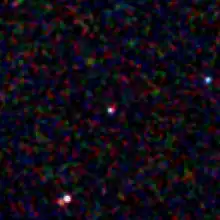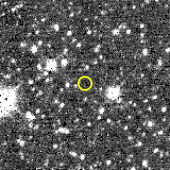Lysithea (moon)
Lysithea /laɪˈsɪθiə/ is a prograde irregular satellite of Jupiter. It was discovered by Seth Barnes Nicholson in 1938 at Mount Wilson Observatory[1] and is named after the mythological Lysithea, daughter of Oceanus and one of Zeus' lovers.[10]
 Near-infrared photograph of Lysithea (center) by the 2MASS survey | |
| Discovery [1] | |
|---|---|
| Discovered by | Seth B. Nicholson |
| Discovery site | Mt. Wilson Observatory |
| Discovery date | 6 July 1938 |
| Designations | |
Designation | Jupiter X |
| Pronunciation | /laɪˈsɪθiə/[2][3] |
Named after | Λυσιθέα Lysithea |
| Adjectives | Lysithean /laɪˈsɪθiən/[4] |
| Orbital characteristics [5] | |
| Epoch 27 April 2019 (JD 2458600.5) | |
| Observation arc | 79.87 yr (29,171 days) |
| 0.0782144 AU (11,700,710 km) | |
| Eccentricity | 0.1478734 |
| +258.57 d | |
| 27.18992° | |
| 1° 23m 32.227s / day | |
| Inclination | 26.29254° (to ecliptic) |
| 343.46495° | |
| 94.80010° | |
| Satellite of | Jupiter |
| Group | Himalia group |
| Physical characteristics | |
Mean diameter | 42.2±0.7 km (WISE)[6] 42.2±3 km (occultation)[7]: 6 |
| 12.78±0.10 h[8] | |
| Albedo | 0.036±0.006[6] |
Spectral type | C/P[6] |
| 18.2[9] | |
| 11.2[5] | |
Lysithea did not receive its present name until 1975; before then, it was simply known as Jupiter X. It was sometimes called "Demeter"[11] from 1955 to 1975.
It belongs to the Himalia group, moons orbiting between 11 and 13 Gm from Jupiter at an inclination of about 28.3°.[12] Its orbital elements are as of January 2000. They are continuously changing due to solar and planetary perturbations. It is gray in color (B−V=0.72, V−R=0.36, V−I=0.74) and intermediate between C-type and P-type asteroids.[13][6]

Lysithea observed by the Wide-field Infrared Survey Explorer (WISE) spacecraft in 2014
References
- Nicholson, S. B. (October 1938). "Two New Satellites of Jupiter". Publications of the Astronomical Society of the Pacific. 50 (297): 292–293. Bibcode:1938PASP...50..292N. doi:10.1086/124963. S2CID 120216615.
- "Lysithea". Dictionary.com Unabridged (Online). n.d.
- Cf. also 'Lysithous' in Noah Webster (1884) A Practical Dictionary of the English Language
- Yenne (1987) The Atlas of the Solar System.
- "M.P.C. 115890" (PDF). Minor Planet Circular. Minor Planet Center. 27 August 2019.
- Grav, T.; Bauer, J. M.; Mainzer, A. K.; Masiero, J. R.; Nugent, C. R.; Cutri, R. M.; et al. (August 2015). "NEOWISE: Observations of the Irregular Satellites of Jupiter and Saturn" (PDF). The Astrophysical Journal. 809 (1): 9. arXiv:1505.07820. Bibcode:2015ApJ...809....3G. doi:10.1088/0004-637X/809/1/3. S2CID 5834661. 3.
- Gomes-Júnior, A. R. (April 2021). "The Irregular Satellites of the Giant Planets" (PDF). Journal for Occultation Astronomy. 11 (2): 3–9. Bibcode:2021JOA....11b...3G.
- Luu, Jane (September 1991). "CCD photometry and spectroscopy of the outer Jovian satellites". Astronomical Journal. 102: 1213–1225. Bibcode:1991AJ....102.1213L. doi:10.1086/115949. ISSN 0004-6256.
- Sheppard, Scott. "Scott S. Sheppard - Jupiter Moons". Department of Terrestrial Magnetism. Carnegie Institution for Science. Retrieved 26 November 2020.
- Marsden, Brian G. (7 October 1975). "Satellites of Jupiter". International Astronomical Union.
- Payne-Gaposchkin, Cecilia; Katherine Haramundanis (1970). Introduction to Astronomy. Englewood Cliffs, N.J.: Prentice-Hall. ISBN 0-13-478107-4.
- Jacobson, R.A. (2000). "The orbits of outer Jovian satellites" (PDF). Astronomical Journal. 120 (5): 2679–2686. Bibcode:2000AJ....120.2679J. doi:10.1086/316817. S2CID 120372170.
- Grav, Tommy; Holman, M. J.; Gladman, B. J.; Aksnes, K. (2003). "Photometric survey of the irregular satellites". Icarus. 166 (1): 33–45. arXiv:astro-ph/0301016. Bibcode:2003Icar..166...33G. doi:10.1016/j.icarus.2003.07.005. S2CID 7793999.
External links
This article is issued from Wikipedia. The text is licensed under Creative Commons - Attribution - Sharealike. Additional terms may apply for the media files.